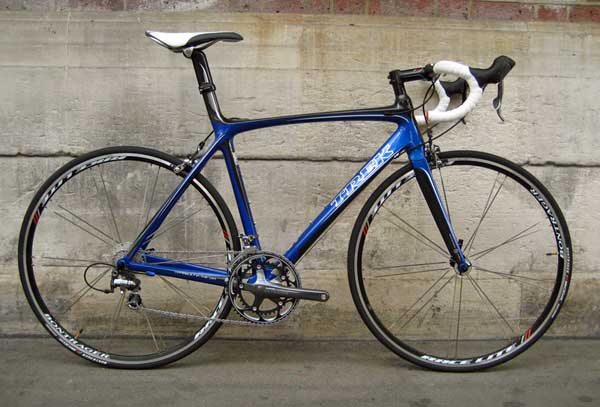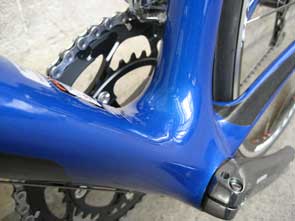 |
|
There’s a lot of history behind the Madone name. First launched in 2003, the Madone has been one of the most successful racing bicycles in the modern era, but when it came to re-launching the bike Trek pulled out all the stops.
This isn’t a simple face-lift and new paint – they’ve started from scratch to develop an all-new bike to thrust the Madone back into the spotlight from which it strayed. The new design makes quite a visual departure from the previous, and heralds in several new design features spreading across the bike world. But is it actually any good?
Frame
Before we get onto how it rides, it’s important to realise just how significantly Trek have redesigned the Madone. Realising how important this release was, Trek knew that a simple makeover of the existing Madone wasn’t going to cut it; the market and consumers have moved on too much in the past couple of years. A brand new bike was required.
And boy, have Trek pulled out all the stops. Put today’s Madone beside a previous generation example, and the only similarities will be the name decaled along the top tube.
There are several trends emerging in road bike design at the moment, chief amongst them a tapered headtube, integrated seat mast and integrated bottom bracket: the new Madone features each of these developments. Trek clearly isn’t taking any chances with its top of the line race bred bike.
The same OCLV (Optimum Compaction, Low Void) process that Trek first pioneered nearly a decade ago is used, but the frame boasts tubes much more bulked out in all the key areas. There’s also a lot more profiling too, with the down tube being squashed vertically as it reaches the wider bottom bracket. Trek has also opted for a compact frame geometry, dropping its previous preference for a traditional geometry.
The most interesting feature is the semi-integrated seat post: this is Trek’s take on the popular vote for an extended seat tube. Rather than require the customer to have to cut the seat mast however, Trek have developed a system that is as easy to use as a normal seat post setup. A ‘stub’ emits from the seat tube, and onto this slides Trek’s seat mast, with a Bontrager single bolt seat clamp. Two lengths and various layback options are available to tailor the fit.
Moving downwards, the bottom bracket now resides in a huge 90mm wide shell, providing a large area of contact for the equally wide down tube. There’s tons of carbon fibre around the BB and, with that huge downtube, flex through the frame is drastically reduced compared to the previous Madone. To allow for this wider BB shell, Trek uses press-fit bearings and ‘Net Moulding’ allows Trek to do away with any aluminium inserts, reducing the weight furthermore.
The final drastic change is a tapered headtube – 1-1/8” at the top for convenience and 1.5” at the lower race makes for a stronger and lighter fork (Trek claim this new fork is 120g lighter than the old model). It must be said that the new range of Madones really impresses. Build quality looks to be excellent, Trek haven’t cut any corners in the finishing and the choice of colours and tasteful decals are pleasing to the eye.
Trek offers two fits across the Madone range, Performance and Pro, the latter as being tested here. Pro is the performance-orientated bike, with a 30mm shorter headtube and double, rather than compact, chainsets. All else remains the same. Simplified too is the OCLV designations, which previously were graded on account of their grade into 55, 100 and 120gsm. Now, Trek has labelled the type of carbon it uses into Carbon Red, Black and White. The 5.2 makes use of Black, which uses an intermediate modulus carbon as opposed to the high modulus used by the higher rung bikes; weight is barely affected, however.
Components
Trek makes no shortcuts with its speccing of the 5.2, plugging into place a full Shimano Ultegra SL groupset. Since its release last year, it’s been a popular choice and for good reason; slick shifting, durability and even the slate grey colour scheme have been whole heartedly adopted by most.
There’s no surprise that Bontrager is the name found on most of the finishing kit; handlebars, stem, wheels, tyres and saddle, but we were surprised to discover just how good the stuff is these days, it really has developed at great pace in the past few years. The handlebars, their shape suiting the tester well, were a highlight. The Bontrager tyres provide grip aplenty and seemed happily robust in a range of test conditions.
Ride
With Trek having changed the classic Madone so much, it was going to be interesting to see how it rides. Fairly amazing, is the answer. The Madone is noticeably stiff, with those oversized tubes and large BB area making an appreciable difference when compared to frames built more conventionally. when you put the power down (imagining you’re Contador) it surges forward but never feels skittish, remaining planted at all times. Even on unfeasibly rough roads, the Madone seems to float across without any distress. It’s admirable that Trek have built a frame that is so impressively stiff but doesn’t reduce your body to a million component parts the moment the road turns rough.
Its race credentials have been well proven this year, with Alberto Contador riding his Madone to many successes. After spending some time on this one it’s easy to see how anyone can extract a lot of performance from it. It has a very neutral feel and never feels nervous. In fact, from the very first ride you’re made to feel right at home. The obvious downside to its neutral ride is that some might mistake it for an uninvolving and even, perhaps, boring, ride. However, this is the bike’s secret – it makes it impressively easy to extract a lot from it, to ride it fast, to take it to its limits. There’s no strange handling traits that must be learned, instead you can just hop on and ride. This is the Madone’s most appealing trait.
Verdict
The Trek Madone made riding a breeze. Stable, planted and fast, the new Madone really is a great achievement for Trek.
 Frame, ride, spec,
Frame, ride, spec,
 Wheels
Wheels













